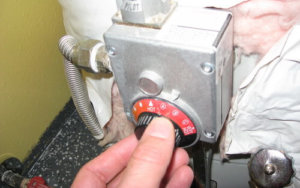How To Clean Water Heaters
Water heaters keep our dishes, clothes, and bodies clean. You might not realize these essential appliances also need cleaning, too. Read on to discover how to clean your water heater and why this maintenance task is so important.
Step-by-Step Water Heater Cleaning

Start by turning off the gas or electricity, depending on your water heater. If you have a gas hot water heater, there’s usually a thermostat at its base. Switch it off, then turn off the valve on the gas pipe connected to your thermostat. If your gas thermostat has a “pilot” setting, you can use that rather than turning the thermostat all the way off. If you do, you won’t need to shut off the valve on the pipe. Turn off the corresponding switch in your breaker box if your water heater is electric.
Turn off the cold water supply to your hot water heater. This valve is usually at the top of your water heater. Then turn on the hot water faucet in a bathtub or sink. Leaving the hot water running while you clean your water heater system prevents a vacuum from forming in the lines.
Put a bucket underneath the drainage pipe and open the pressure relief valve. Opening the pressure relief valve helps water flow more freely during cleaning. The water that drains away will be very hot, so take care with this step. If no water comes out, your pressure relief valve must be replaced.
Let the water in your hot water tank cool before moving on to the next step. Once it’s cooled, connect your garden hose to your water heater’s drainage spigot. Ideally, the hose’s other end should lead outdoors. If your hose isn’t long enough, put it in a bucket.
Turn on the spigot and drain the water from your water heater until it turns clear. Once you’re done, you shouldn’t see any sediment in the water.
Turn on the cold water spigot to your hot water tank to flush the system. Let the water run until the water leaving your hose is clear. This can take some time, depending on how dirty your water heater is, so be patient and wait for all the sediment to leave the system. Then turn off the cold water spigot in your hot water tank.
Now it’s time to return your hot water system to an operational state. Turn off the drainage spigot and remove the hose. If you close the pressure relief valve, open it back up. Turn off the hot water in your sink or tub and turn on the cold water spigot to your hot water heater. Wait until your tank fills up, then open the pressure relief valve to let excess air escape.
Turn the hot water in the sink or tub back on to let air in the system escape. This water should feel cold. Let it run for a minute or two before shutting it off again.
If you have a gas water heater, turn the gas back on. You’ll need to relight the pilot light, then turn the thermostat to the on position. If your hot water heater is electric, flip the breaker switch back on to restore power. It should take roughly 20 minutes for the water in your water heater to heat up. Turn on a faucet after this time to check that the water runs hot.
Why Clean Your Water Heater?
Your home’s water supply contains chemicals, minerals, and sediment. These particles can build up inside your system. Cleaning your water heater removes the deposits impacting your system’s work.
A clean water heater runs more efficiently. A dirty water heater may heat unevenly. Deposits can also block elements so they don’t light correctly. Sediment can also clog your drainage filters. All these problems can impact your power bills, as your system must work harder to overcome these issues. When you remove the sediment and help your water heater run as it should, you should notice an immediate reduction in your power bills.
When a water heater runs efficiently, its components also have less wear and tear. That means when you clean your water heater regularly, it’ll last longer. A properly maintained water heater can easily last 10 years or even more.
In extreme cases, the sediment that builds up in your water heater can cause leaks. Water heater leaks tend to be major leaks, causing flooding rather than dripping so they can cause water damage in your home. You cannot repair water heater leaks like pipe leaks. The cost of a new water heater and repairing damaged or replacing destroyed property can be substantial. And to think it’s so easily avoided by cleaning your water heater.
How Often Should You Clean Your Water Heater?
Depending on your water heater and water supply, it will usually need cleaning every one to three years. You can’t over-clean your water heater, though, and it’s a quick and easy job, so it makes sense to do it annually as a precaution. It’s a good idea to choose a regular date, such as the first day of summer, so you don’t overlook this important maintenance task.
If your area’s water supply has a lot of sediment, you may want to clean your water heater as often as every month or two. Alternatively, you could install a water softener. It removes calcium and magnesium from your water supply, so fewer contaminants flow through your water heater. With a water softener, you should be able to clean your water heater annually, like most people.
If you’re not sure of the right schedule for your home, look out for warning signs your water heater needs cleaning. If you can’t get hot water, your water smells funny, or your water heater makes strange noises, cleaning your water heater may solve the problem.
Regularly cleaning your water heater can extend the life of your unit, but nothing lasts forever. When it’s time to upgrade to a new unit, contact Allied Plumbing & Heating Supply Co. We have a range of quality water heaters for households of all sizes and budgets. Browse our water heaters and other plumbing products online today.
Photo Credit: Image via Flickr by Mark Florence


